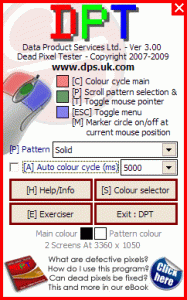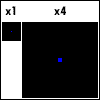Dead Pixel Tester
admin2024-04-07T21:02:33+00:00Dead Pixel Tester with display aids and illusions.
 Dead Pixel Tester, with display tests. NEW VER 3.00 – TFT screens have thousands of pixels, on a 1024×768 monitor, there are three cells for each pixel – one each for red, green, and blue – which amounts to nearly 2.4 million cells (1024x768x 3 = 2,359,296). There’s only a slim chance that all of these will be perfect; more likely, some will be stuck on (creating a “bright” defect) or dead (resulting in a “dark” defect). DPT was written to help me check my own screens (Couldn’t find one that worked across multiple desktops so had to write my own!) by cycling through the three primary colours used (red, green, blue) and all on (white) and all off (black).
Dead Pixel Tester, with display tests. NEW VER 3.00 – TFT screens have thousands of pixels, on a 1024×768 monitor, there are three cells for each pixel – one each for red, green, and blue – which amounts to nearly 2.4 million cells (1024x768x 3 = 2,359,296). There’s only a slim chance that all of these will be perfect; more likely, some will be stuck on (creating a “bright” defect) or dead (resulting in a “dark” defect). DPT was written to help me check my own screens (Couldn’t find one that worked across multiple desktops so had to write my own!) by cycling through the three primary colours used (red, green, blue) and all on (white) and all off (black).
Basic usage
 Ensure your screen is free from dirt and marks,if possible clean it with correct recommended products.
Ensure your screen is free from dirt and marks,if possible clean it with correct recommended products.- Make sure your screen resolutions are correct for your monitor, e.g. if your screen is 1680×1050, make sure the resolution for that monitor is set at 1680×1050.
- Use the right mouse button to toggle the main menu on and off, so that you can see the whole screen without any interference.
- Use the left mouse button to toggle through the basic application colours of Black (Check for stuck on pixels), Blue (Check for dead blue pixels), Red (Check for dead red pixels), Green (Check for dead green pixels), and White (Check for dead pixel group)
- Each time you select a new colour, scan your screen carefully looking for defects (Black spots will be dead pixels on any colour screen)
- Use the [M] key to toggle a Marker at any suspect point on the screen. This allows you to scan the rest of the screen and come back to that area/check the screen is clean. Hint : After placing a Marker you can move about to check if the pixel moves in the area or not. If it does not move then it is most likely a dead pixel, if it does move then it is probably a mark on the outside of the screen.
Why do I need/would want to use this program?
In most cases, a stuck or dead pixel is impossible to fix (some people rub them gently with a cloth etc. search the net for other ways), however most manufacturers have a policy which will specify that after X amount of dead/stuck pixels they will replace the screen free of charge (in warranty period). You can use DPT to help identify IF you have any pixels and how many in order to see if you qualify for a replacement screen/laptop… no guarantees though!
- Move the window by grabbing the border at any location
- The [x] in the top right hand corner hides the screen, you can also use Right mouse button or [ESC]
- Click the www.dps.uk.com text to visit our site
- Left mouse click: Cycles though the basic colours Red, Green, Blue, Black and White
- Middle mouse click: Toggles the mouse cursor on and off, scrolling the wheel changes the display pattern
- Right mouse click: Shows and Hides the Main Menu
- Pattern selection: Toggles between a solid colour on the screen and a selection of patterns (also display utilities). All the patterns are 1 pixel wide to help make spotting dead pixels easier. The secondary colour (off colour) can be chosen via the Direct Colour Selection
- Markers: New in version 2.50+ is a small marker function. Where ever the mouse currently is, press the [M] key and a small circle will be drawn at this point. This allows you to move your focus, clean the screen and easily find the position again. You can remove the marker by simply placing the mouse back in to that position and pressing [M] again, or use [R] to remove all the markers on the screen.
- Auto Cycle: Automatically colour cycles as if you where pressing the mouse button. Next to this you can change the speed at which this occurs in milliseconds (1000ms=1second)
- Exit: DPT: Closes this application, before you close you will be asked if you would fill in our short survey.(We would be most thankful!)
- Main colour: Shows you the current colour selected
- Pattern colour: Shows you the secondary colour you currently have selected (from the Direct colour selector, using the secondary mouse button)
- Information: Basic information on your current screen resolution.

Blue pixel not responding on a blue background, middle pixel is black instead of blue

Blue pixel not responding on a white background, middle pixel shows as yellow instead of white

Blue pixel not responding, but stuck on, middle pixel shows as blue instead of black
What does this program NOT do?
- AUTOMATICALLY POINT OUT YOUR DEAD PIXELS – this is physically impossible for any application to do, all this program does is display colours and grids to try and help you identify dead/stuck pixels. Use the Markers to help find them and make sure your screen is not dirty.
- Contact the web or send ANY information or store any information (In fact you can run it directly off a USB disk or floppy even!)
Additional information
By changing the pattern to vertical/horizontal lines and the hash patterns it is easier to see dead pixels as well. The hash pattern does not work very well on monitors that are connected via analogue, unless they have been very well set up.
Just for fun I’ve some different illusions patterns, some of these work better than others, but are great fun to see:-
- Black dots: A series of white dots connected with grey lines, but there looks like there are black dots in the white dots
- Spinning circles: When you move your eyes, the circles appear to spin
- Cafe wall: Spotted in a cafe, the grey horizontal lines appear to bend, not be straight
- Solid grey bar: By having a gradient colour in the background, the grey main bar in the middle appears to also have a gradient effect, but it is in fact only one colour.
- Waves: Again when you move your eyes the pattern appears to be moving in waves, freaky!
There is also a host of other Patterns that allow you to check the saturation / Intensity and so forth of your screen. We are always open to new ideas for screens etc.
2,269,257
Download Count
